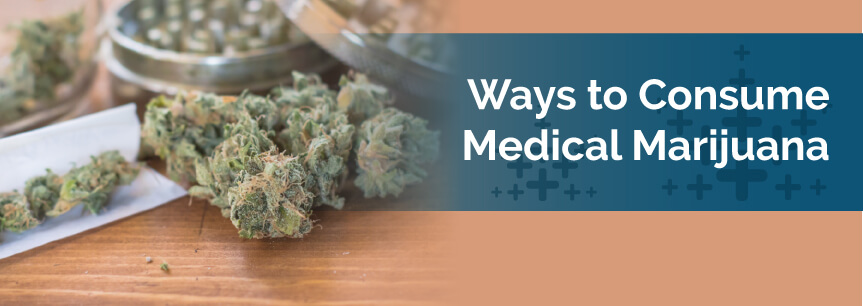
Consuming medical marijuana is not quite the same as taking a pill for a headache. Marijuana is a plant with a complex chemical make up. When grown in a lab, marijuana can be bred for consistency, but there are still variations from plant to plant.
The other side of the equation is the delivery method. There are many ways to consume marijuana. Each one has it benefits and detractions, and no two ways deliver the same dosage in the same way. Using marijuana for its medicinal value can be complicated.
Once you achieve the desired affects, however, you will be happy there are so many variations. With some patience and experimentation, you can find the type of marijuana and the means of consumption that gives you the biggest benefit for your unique situation.
We cover each in more detail below, but the main ways to consume medical marijuana are:
Before you begin taking medical marijuana, it helps to know a little about it. A marijuana doctor will make recommendations for your specific situation, but you will still have some latitude to decide what works best for you. A better understanding of the chemicals you are dealing with will make medical marijuana less intimidating for you.
There are three main varieties of cannabis plants: indica, ruderalis and sativa. Most of the cannabis grown today is a hybrid of cannabis indica and cannabis sativa. In addition, the plant breeders who are developing the seeds create thousands of variations.
While all medical marijuana provides similar benefits, the specific effects of sativa and indica are somewhat different from each other.
Indica benefits include:
Sativa benefits include:
Hybrid forms of cannabis offer a cross-section of benefits. Most include reduced nausea and increased relaxation. When the dose is too high, however, some of the cannabis benefits turn into negatives, including increased anxiety, insomnia or paranoia.
Various cannabis hybrids are bred to isolate different cannabinoids for their specific affects. THC was the first compound discovered in cannabis, and it has the most psychoactive affects. Other compounds have been isolated and determined to provide therapeutic benefits without the high.
For medicinal marijuana, it is important that the various effects of cannabis can be separated. Here are some of the compounds found in marijuana and their effects:
Breeders try to adjust their hybrids to balance the amount of certain compounds in each type of cannabis. By making adjustments, they can create medical marijuana that focuses on a particular type of therapy. The goal, of course, is to breed in the best benefits while breeding out the negative side effects.
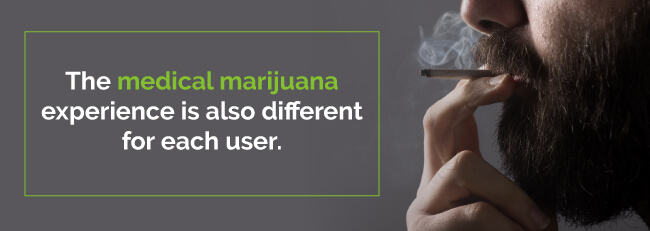
These variables make each variety of medical cannabis different. The medical marijuana experience is also different for each user. Some of the personal variables that effect the results of cannabis consumption include:
With all of the plant variations and these personal variables, there are a lot of opportunities to consume medical marijuana in a way that provides you with the greatest benefits for your condition. If you try medical marijuana therapy and it doesn’t work or it produces side effects you are not comfortable with, you can try other variations until something is successful for you.
Medical marijuana is a versatile medicine that is used by patients across the country to alleviate the side effects and symptoms of countless medical conditions, including cancer, HIV/AIDS, multiple sclerosis, glaucoma and more. Many new patients wonder how to medicate with marijuana or how to take marijuana.
If you don’t have experience, learning how to use medical marijuana can be difficult. You might only associate weed with smoking, but there are several other ways to take advantage of the many medical benefits of weed. Here is some information on the different ways medical marijuana can be administered, so you can a well-informed decision about which is right for you.
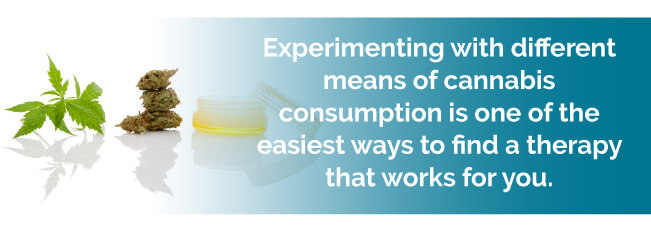
Experimenting with different means of cannabis consumption is one of the easiest ways to find a therapy that works for you. There are several different ways to consume medical marijuana, and each has a unique experience. Here is a comprehensive list of the ways cannabis can be consumed:
Perhaps the most well-known delivery system for marijuana is smoking. The cannabis is dried and rolled into small cigarettes. A consumer inhales the medicinal compounds with the smoke, and its effects are felt almost immediately.
Smoking is the most common method that comes to mind when someone thinks about how to use medical cannabis. You take a small portion of marijuana and either roll it into a joint or place it in a pipe or bong. You simply hold a flame to the end of the joint or the bowl of the pipe or bong and then inhale. The advantages of smoking include quick relief from your pain, nausea or other symptoms, easy dosage regulation and low cost. The drawbacks include possible lung irritation. Smoking isn’t typically recommended for someone with asthma or lung problems. If you’re just starting out, only take a small hit at first to make sure you don’t have a violent coughing fit.
The dosage from smoking is more consistent when the cannabis is smoked in a pipe, rather than in a cigarette form. The smoke from burning marijuana carries the medicinal properties out one end of the cigarette while you are inhaling from the other end. A pipe, or bong, re-captures some of that second-hand smoke and delivers it back to the user.
Many people turn to edible products when deciding how to use medical marijuana. Options used to be limited to brownies or cookies, but now there are myriad ways to ingest weed, including crackers, chews, chocolate bars and even ice cream and lollipops. The advantages are that edibles taste great, you can precisely manage your dose, and the relief they provide typically lasts a long time. The downside is that it can take a long time for the effects to kick in — anywhere from 30 minutes to several hours. You’ll also need to make sure to keep your edibles away from children and pets.
Food is a slower delivery method for medical marijuana, but it’s one that might be more palatable to inexperienced users. Cannabis that is ingested travels through the digestive system before entering the bloodstream and then making its way to the brain. Several organs become involved in processing marijuana edibles.
The trip that most edibles take through your digestive system actually concentrates their effects. It may take longer to kick in, but when you start to feel the effects of your edible marijuana treats, they could be stronger than you anticipated.
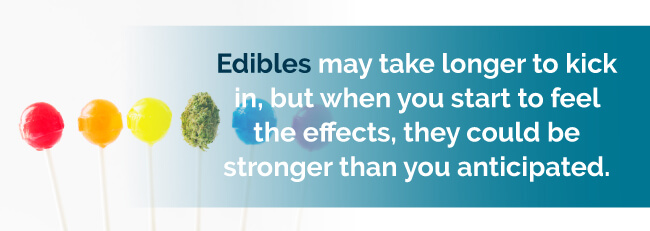
Since the effects of cannabis edibles are not immediately felt, it is easy to over-consume. By the time you feel the marijuana working, you might have eaten far more than you needed to get the job done. The results could be an uncomfortable high as the entire dose of cannabis hits your brain.
Check out our marijuana edible recipes for great ways to cook with marijuana.
Topical solutions such as lotions, ointments, sprays, salves and others have long been used for muscle soreness, joint pain, tendinitis and other issues. Marijuana topicals provide the benefits of weed without producing a high, and they have shown to be very effective in providing localized relief of pain. The drawbacks include the fact that topicals are not good for certain conditions, such as epilepsy, glaucoma and others. You might need to consider a patch if you experience any sort of skin irritation.
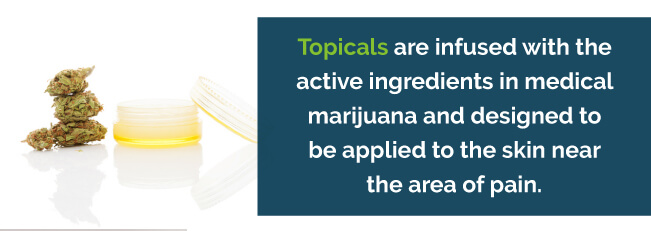
Topicals are creams and lotions infused with the active ingredients in medical marijuana. They are designed to be applied to the skin near the area of pain or inflammation. The benefits of the cannabis are then absorbed through the skin and go to work directly in the area where they are needed.
Certain diseases and cancers produce localized physical pain that can be treated with topical applications of medical marijuana. By using cannabis in a topical form, you can get the pain-relieving benefits without getting high. The euphoric effects of marijuana are completely bypassed with this application.
Topicals are good for localized inflammation and pain. They are also a good choice when you want the healing benefits of cannabis but not the psychoactive effects. You can use marijuana topicals and remain clear-headed, focused and sharp.
Consuming cannabis in this way looks a lot like smoking, but there are some differences. Vaporizing, or vaping, can release the chemical compounds in the marijuana at a lower temperature than smoking. The flavor of vaporized cannabis is much different from the burnt taste of smoking it, also. Consuming marijuana vapors protects your lungs from the high heat of smoking.
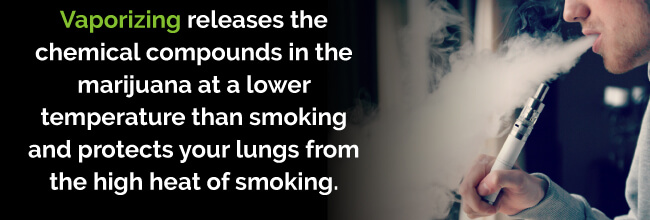
There are several different types of vaporizers, and they come in a wide range of shapes and sizes. You preheat the device to whatever temperature is recommended by the manufacturer, and then put the weed or cannabis extract into the unit. Then you simply press a button and inhale. Vaporizing is less harsh for the lungs than smoking a joint, pipe or bong, and you won’t have to deal with smelling like smoke. Vaporizers can be more expensive, and you have to recharge battery-powered units. It can take some time for the device to warm up. If you don’t have any experience with a vaporizer, you should take a small hit at first until you get used to it.
Vaporizing can be accomplished by a number of different apparatus. The portable kind are small enough to hold in your hand and can be used on-the-go. You can also get a table-top vaporizer to use at home. The larger appliances offer more sophisticated temperature controls.
Many people use products that they squirt or spray into their mouths to get the relief they need. Tinctures and sprays are usually a mixture of cannabinoid extracts and oil, alcohol or glycerin. They typically come in a small bottle and are absorbed through the mouth. This method doesn’t irritate the lungs like smoking or using a vaporizer. You can easily control your dosage, and there is only a mild taste. Tinctures and sprays take a while to take effect, and can be expensive if you need high doses. Start slow until you determine the right dosage for you.
A tincture is made by soaking the marijuana plant in an alcohol and water mixture for at least six weeks. During that time, the alcohol and water soluble compounds within the plant are transferred to the liquid. The liquid is then tested and used for dosing.
Medical marijuana consumed in the form of a tincture is usually taken in small doses. One or two milliliters are placed under the tongue with an eye-dropper. A tincture can also be added to food, but that slows the absorption rate.
Tinctures maintain their potency for a long period of time when they are stored correctly. When they are exposed to the air for too long, tinctures are subject to evaporation. This is why putting a couple drops under your tongue is the most efficient way to consume a cannabis tincture.
When absorbed through the skin or mucus membranes, the medical marijuana tincture acts immediately. It goes directly into your bloodstream, and its effects can be felt right away. This form of marijuana consumption makes it easy to dose very accurately.
Like other medications, medical cannabis can be taken in a suppository form. The active ingredients are absorbed quickly through the colon, and the effects can be felt very quickly. Using suppositories can be messy and difficult, but it is a way to avoid smoking and bypass most of the digestive system.
A medical marijuana suppository is what you would expect it to be. The cannabis or extract is placed into the rectum and then absorbed through the colon. It can be an embarrassing way to medicate, but many patients say they would never consider any other option. Effects kick in quickly and last a long time — just make sure you wear protective gloves and thoroughly wash your hands after you apply your dose.
Suppositories are available in two strengths, and they can be cut in half to reduce the dosage. They need to be refrigerated, however, which makes them impractical for use away from home. Suppositories can be a good alternative to people who have trouble swallowing and want to protect their lungs from smoke or heat.
Suppositories are also easier to keep safe from others. Curious children or teens might be interested in trying marijuana edibles or even cigarettes. Suppositories do not tend to garner the same fascination as other forms of medical marijuana.
Dabbing is a rather advanced means of consuming medical marijuana that should be reserved for experienced users. This method vaporizes the cannabis very quickly and delivers a concentrated dose. The vapor is safer for your lungs than inhaling smoke, and the practice is very quick.
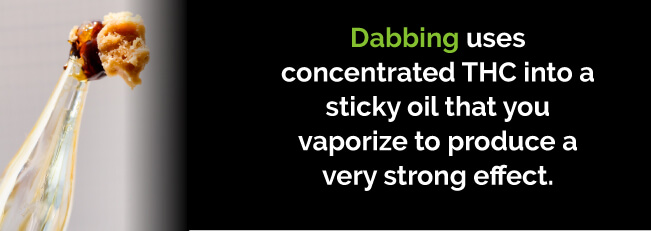
Cannabis dabs are made using butane, carbon dioxide or some other solvent. The THC in the marijuana is concentrated into a sticky oil that goes by street names like budder, shatter, butane hash oil and wax. Vaporizing these cannabis concentrates produces a very strong effect.
A dab of cannabis is dropped onto a hot surface and then inhaled. A small metal or glass surface is used and heated with a lighter or a blow torch. It needs to get really hot to vaporize the dab on contact. There are obvious dangers involved in this method of cannabis consumption.
The medical benefits of dabbing, however, include effective relief from some of the worst symptoms. Dabbing results in immediate cessation of extreme pain or nausea. It is able to deliver an extremely concentrated dose of medical marijuana almost instantly to the brain.
You’ve probably heard of nicotine patches to help kick the habit of smoking tobacco. Medical marijuana transdermal patches are similar. You put a patch on a clean, hairless surface, such as the inner portion of the wrist or the top of the ankle or foot. If you don’t want to smoke weed, transdermal patches are a great option. Some people can develop an allergic reaction to transdermal patches, so pay close attention to your skin.
Patches are becoming a more common means of delivering medication. Medical marijuana patches are a small piece of adhesive material meant to be stuck on the skin. The patch delivers a time-released dose of medication over a long period of time.
Transdermal patches, unlike topical lotions, put the active ingredients right into your bloodstream, so the pain relief is felt everywhere in your body. Topicals are used for specific areas and are applied just near the pain. Transdermal patches, because they deliver medication through all layers of skin into the bloodstream, are for general, not localized, pain relief.
One benefit of a transdermal patch is that your body can absorb the entirety of the dose. With other delivery systems, you are not getting the benefit of the amount you take. With a patch, the medicine is not traveling through the digestive system or being lost or altered in any way.
Marijuana is a plant that can be eaten raw. By ingesting fresh cannabis, you are preserving all of the contents and active ingredients, even those that might be lost in the drying or heating process. The best way to consume fresh marijuana is by adding it to juices and smoothies.
Fresh cannabis does not have a very inviting flavor, so most people put it in the juicer or the blender and add other ingredients. Like with other fresh vegetables, marijuana releases its nutrition the moment it is cut or pureed, so drinking it right away will give maximum benefits.
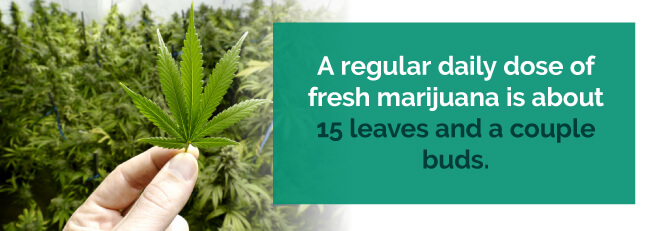
A regular daily dose of fresh marijuana is about 15 leaves and a couple buds. This method of consuming fresh cannabis requires a rather large supply. It is also difficult to determine the exact dose of THC and other medicinal compounds you are getting from each drink.
The best part of consuming raw cannabis is that you are not leaving any medicinal compounds behind. Everything that is in that plant is going into your body in its freshest form. The marijuana still has to travel through your digestive system, though, so consuming it raw does not result in quick symptom relief.
Several types of beverages infused with marijuana are available for sale, including wine, soda and tea. Maintaining strict dosing with these beverages is difficult, but they provide an alternative to inhaling smoke or vapor.
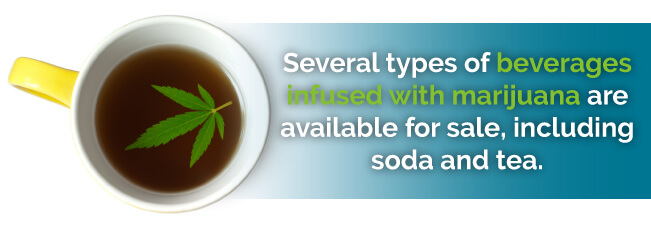
Because beverages travel through your digestive system, the effects of the marijuana do not kick in right away. These beverages can be used for a slow acting, long-lasting affect. They tend to also provide relief from stress and anxiety.
You can also make your own cannabis tea by steeping the leaves, stems and buds in boiling water for at least a half hour. To dissolve the THC in the marijuana plant, you have to add either alcohol or oil to the mix. Some people recommend adding other things for flavor before drinking this tea. Cannabis tea by itself does not have a very pleasing taste.
All drugs have side effects. The goal is to find a therapy that works for you and has side effects you can live with. If you are searching for a healthy way to consume cannabis, there are some things to consider:
Inhaling very hot air is dangerous to your throat and lungs. These organs are lined by mucous membranes that are meant to remain moist. Extremely hot air dries them out and causes irritation. Once the mucous membrane is dry, it can be easily damaged and allow infections to set in.
Treating your marijuana like a vegetable is probably the healthiest means of consumption. Adding several fresh leaves to a smoothie gives you the opportunity to combine the medical benefits of cannabis with other foods that may make the nutrients more bio-available. Getting the most out of your marijuana could be a smart move.
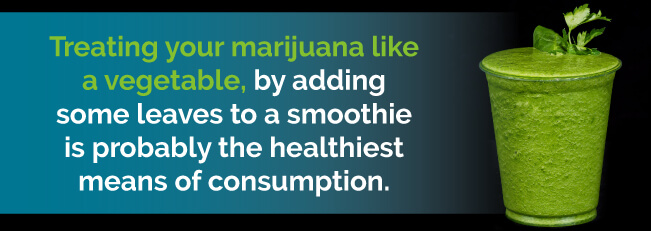
The health benefits of marijuana were only recently discovered and are still being understood my medical science. However, we do know cannabis is a plant that can improve the health profile of many people who previously had no hope of living comfortably. That means the healthiest way to consume cannabis, no matter which actual method you use, is to take it for healing.
For more information on the best ways to consume medical marijuana, or for a professional consultation search for a medical marijuana doctor or dispensary. Our pre-screened marijuana doctors are experienced doctors licensed to prescribe marijuana. They will be able to help you find the right medicinal cannabis product and delivery method for your unique situation.